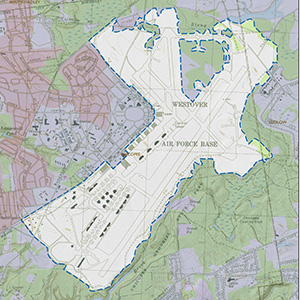Important Bird Area Sites in Massachusetts
Important Bird Area: Westover Grasslands Complex
Site Summary
Nominated By
Geoff LeBaron
Size
1,600 acres
Towns and Counties
Chicopee; Hampden
Ownership
federal military
Major Habitats
50% cultural grassland, 20 % sandplain grassland, 15% early successional shrubland, 15% powerline
Land Use
military, urban, industrial, commercial, other recreation
Serious Threats
ecological succession
Minor Threats
invasive plants, predators, habitat conversion
IBA Criteria
- Category 1: Sites important for long-term research and/or monitoring projects that contribute substantially to ornithology, bird conservation, and/or education.
- Category 2: Sites containing assemblages of species characteristic of a representative, rare, threatened, or unique habitat within the state or region.
- Category 4: Single-species Concentrations: The site regularly supports significant concentrations of a flocking species, but may not meet the thresholds above. The site should support a higher proportion of a species' statewide population (more than 1%, if known) than other similar sites.
- Category 5: Sites regularly holding significant numbers of species of high conservation priority in Massachusetts.
Site Description
Westover Air Reserve Base is an Air Force training base. The habitat type on the base consists of oak woodlands, extensive wetlands and vernal pools, red pine plantations, and grasslands. Grasslands cover approximately 1,600 acres. The IBA is located on the outwash plain, a remnant of glacial Lake Hitchcock. The soils in the grasslands are sandy and dry, with patches of wetlands in low-lying areas. Before Westover became a military base in the 1950s, the grasslands were referred to as Chicopee Plains, a common pasture for grazing cattle. Because of human use, the grasses and forbs are a mixture of native and introduced species. Management of the grasslands at Westover consists of annual mowing after July 31. Grasslands near the runway (within 50 feet) are mowed more frequently to detract birds and insects. (Westover Air Reserve Base is not open to the public, and any one wishing to visit the facility must make arrangements in advance through the public affairs office.)
Current Conservation Status
No statutory protection. Westover Air Reserve Base has been managing and improving habitat for grassland birds since 1985 when staff began curtailing mowing in areas removed from runways until after the end of the breeding season. As a result, populations of many species of grassland birds have more than tripled. In addition, the base has restored several areas to native grassland habitat, considering the habitat needs of grassland birds while still managing the area as an active base. At Westover Air Reserve Base, there is no formal protection of the land. If the base were closed, if there were a national emergency, or in the event of a change in policy of the military base commander, the critical areas for grassland species could quickly and easily be lost. Even with status-quo ownership and access to the property by researchers, grassland management issues on a seasonal basis are an ongoing problem. Minor shifts in mowing regimes of the areas surrounding the runways could drastically affect nesting success of grassland species. Furthermore, there are bird strike issues to be dealt with on an ongoing basis. Some culling of key species is undertaken at this time, and without proper management the issue of bird strikes and the military's reaction could become a larger problem.
Ornithological Significance
The site contains the largest concentration of rare grassland birds in New England. Roughly 50 percent of the state's Grasshopper Sparrows, and fewer than 75 percent of state's Upland Sandpiper breeding populations are on the site. Many other high-conservation-priority species associated with open habitats regularly breed on the facility including the American Kestrel, American Woodcock, Black-billed Cuckoo, Eastern Kingbird, Brown Thrasher, Prairie Warbler, Indigo Bunting, Eastern Towhee, Field Sparrow, Bobolink, and Eastern Meadowlark. In addition, there are good numbers of Blue-winged Warblers and Gray Catbirds nesting, representing significant proportions of the breeding populations of these species in Massachusetts. The base contains both native grassland habitat and cultural grasslands that are suitable for nesting grassland species. In addition, the area is regionally important as a migratory stopover point for some species (e.g., American Kestrel) and often harbors wintering open-country species such as the Snowy Owl and Snow Bunting. This site is also important as a location for long-term monitoring of grassland breeding birds including graduate research and biannual inventories by MassWildlife.
Other Flora or Fauna of Significance
The unusual geology of this site contains unique habitats of native warm-season grasslands and peatlands, providing habitat for many rare and unusual plants and invertebrates. Large areas of the sandiest portions of the grasslands are covered in flowering Lupine in June.
Data Sources
A. Jones, H. Allen, G. LeBaron, personal observations
Jones, A L. 2000. breeding ecology of Grasshopper Sparrows in Massachusetts: a comparison of insular and mainland populations. Chapter 1, M.S. Thesis, University of Massachusetts, Amherst, MA.
Jones, A.L., and P.D. Vickery. 1997a. Distribution and population status of grassland birds in Massachusetts. p. 187-199 in Grasslands of Northeastern North America (P. D. Vickery and P. W. Dunwiddie, eds.). Massachusetts Audubon Society, Lincoln, MA.
Jones, A.L. 1997. Conserving Grassland Birds: managing large grasslands including conservation lands, airports, and landfills over 75 acres for grassland birds. Massachusetts Audubon Society, Lincoln, MA.
Melvin, S.M. 1994. Grassland bird survey at Westover Air Reserve Base. Massachusetts Division of Fisheries and Wildlife, unpublished report.
Melvin, S.M. 1999. Grassland bird survey at Westover Air Reserve Base. Massachusetts Division of Fisheries and Wildlife (unpublished report).




